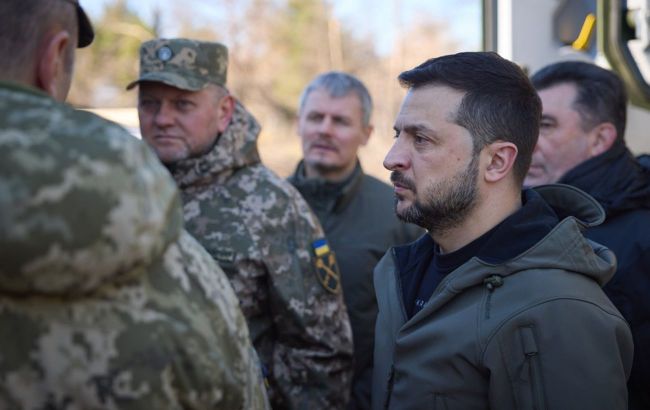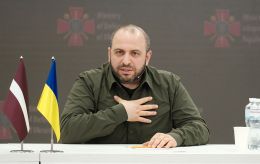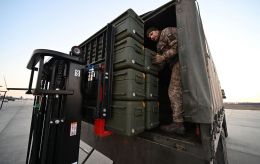What lies behind conflict between Zelenskyy and Zaluzhnyi, details
 Photo: Relations between Zelenskyy and Zaluzhnyi have long been tense (president.gov.ua)
Photo: Relations between Zelenskyy and Zaluzhnyi have long been tense (president.gov.ua)
News about the disagreements between President Volodymyr Zelenskyy and chief of the General Staff of the Armed Forces of Ukraine Valerii Zaluzhnyi began to emerge long ago. However, this issue became particularly acute recently, as information about the possible dismissal of the general started to surface more frequently in recent days.
To understand the conflict between Zelenskyy and Zaluzhnyi, read the material below by RBC-Ukraine.
Zaluzhnyi's rating and his charitable foundation
It is worth noting that discussions about the conflict between Zelenskyy and Zaluzhnyi first arose in April 2022. During that month, there was information about the chief of the General Staff creating his charitable foundation to support the army. The foundation was quickly renamed, but this step was interpreted as a sign of the chief of the General Staff having political ambitions at the Presidential Office.
This interpretation gained strength, especially considering the solid foundation that had already been laid. Immediately after the full-scale invasion, the level of support for the Armed Forces rose to 98%, according to a survey by the Rating group – even higher than Zelenskyy's personal support rating (93%). Zaluzhnyi, who was not widely known before the major conflict, quickly became a popular figure on a national scale.
Of course, Zelenskyy's team did not ignore this. Sources from various institutions and groups within the ruling team, the head of the Office, Andriy Yermak, was most actively pushing this topic.
First public signs of conflict
The tension between Zelenskyy and Zaluzhnyi first became public in the summer of the first year of the major war. The trigger was the disclosure of an internal General Staff document that required the military enlistment office's permission for the movement of military conscripts within Ukraine.
The document caused a significant resonance, and Zelenskyy promised to promptly resolve the situation and urged the General Staff "not to make such decisions without him." At the same time, the president, of course, denied any conflicts with the military leadership and emphasized the unity of the team. "I think this is nothing. Mistakes need to be corrected, that's all," Zelenskyy said at the time.
Zaluzhnyi's publications in the media
One source assures RBC-Ukraine that in late summer of the previous year, an agreement was reached that Zaluzhnyi would no longer appear in the media and would focus exclusively on military actions.
However, on November 1, the renowned column by the commander-in-chief appeared in The Economist, along with his more detailed essay on why Ukraine cannot radically change the situation on the front in its favor at the moment and what it needs to do for that. It was perceived very sharply at the Presidential Office not only due to the violation of the agreement but also because of the content: Zaluzhnyi's narrative sharply contradicted Zelenskyy's narrative that the situation was by no means a stalemate. As a result, first, the Office, and then Zelenskyy personally, made critical statements about the general.
Other sources in the security forces claim that there was no agreement between the commander and the Office regarding a ban on his media activity. Although during the big war, his interviews were indeed few. According to the interlocutors, permission for them was obtained from the Minister of Defense. As for the column in The Economist, its release was allegedly known, but its content was not.
"Failed" counteroffensive
In addition, the situation sharply escalated with the actual failure of the counteroffensive. The Office assures that the source of all optimistic forecasts was the generals' assurances of the operation's success, which they shared at meetings of the General Staff and in communication with Zelenskyy.
Later, the president and other top officials of the country conveyed this optimistic narrative to the media. However, it later became clear that there was no grand breakthrough in the Russian defense lines.
"Zelenskyy was very upset about it. When it comes to significant matters, like a counteroffensive, it naturally enrages when you're not being told the truth," the interlocutor notes. In response to RBC-Ukraine's remark that the Armed Forces of Ukraine did not receive everything necessary from the West for success, especially in the air, he replies, "And was it not immediately clear that the advantage in the air would be with the Russians? Why draw rainbow pictures?"
Frontline visits
There were other reasons for conflicts as well. One interlocutor in the military-political leadership recalls how, after some time after the full-scale invasion, Zelenskyy began to visit the front and personally communicate with brigade commanders and soldiers – while Zaluzhnyi remained in Kyiv for a long time (although, of course, no one demanded that the commander-in-chief personally lead people into attack). "Then the question arose: can the commander fully understand the real needs of people on the front if he does not communicate with them himself," recalls the interlocutor.
For detailed information on what happened between Zelenskyy and Zaluzhnyi and what is known about the possible dismissal of the chief of the General Staff, read the material by RBC-Ukraine.

